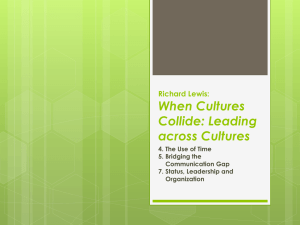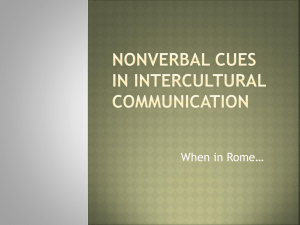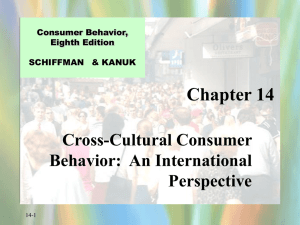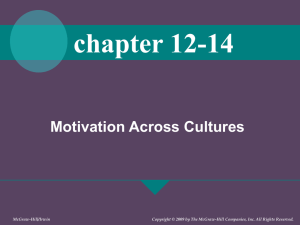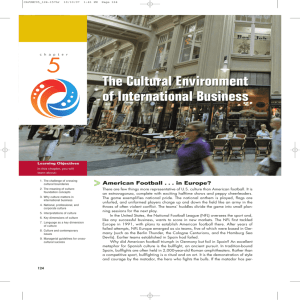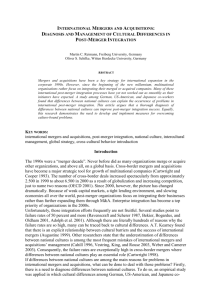Cross-Cultural Communication Strategies
advertisement
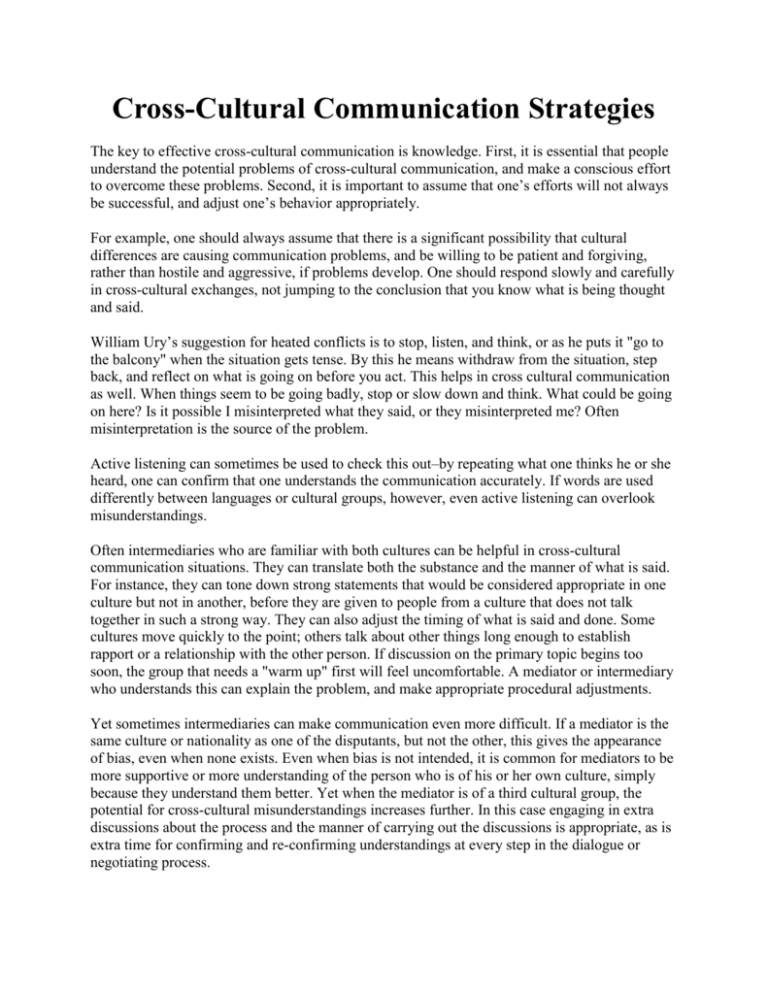
Cross-Cultural Communication Strategies The key to effective cross-cultural communication is knowledge. First, it is essential that people understand the potential problems of cross-cultural communication, and make a conscious effort to overcome these problems. Second, it is important to assume that one’s efforts will not always be successful, and adjust one’s behavior appropriately. For example, one should always assume that there is a significant possibility that cultural differences are causing communication problems, and be willing to be patient and forgiving, rather than hostile and aggressive, if problems develop. One should respond slowly and carefully in cross-cultural exchanges, not jumping to the conclusion that you know what is being thought and said. William Ury’s suggestion for heated conflicts is to stop, listen, and think, or as he puts it "go to the balcony" when the situation gets tense. By this he means withdraw from the situation, step back, and reflect on what is going on before you act. This helps in cross cultural communication as well. When things seem to be going badly, stop or slow down and think. What could be going on here? Is it possible I misinterpreted what they said, or they misinterpreted me? Often misinterpretation is the source of the problem. Active listening can sometimes be used to check this out–by repeating what one thinks he or she heard, one can confirm that one understands the communication accurately. If words are used differently between languages or cultural groups, however, even active listening can overlook misunderstandings. Often intermediaries who are familiar with both cultures can be helpful in cross-cultural communication situations. They can translate both the substance and the manner of what is said. For instance, they can tone down strong statements that would be considered appropriate in one culture but not in another, before they are given to people from a culture that does not talk together in such a strong way. They can also adjust the timing of what is said and done. Some cultures move quickly to the point; others talk about other things long enough to establish rapport or a relationship with the other person. If discussion on the primary topic begins too soon, the group that needs a "warm up" first will feel uncomfortable. A mediator or intermediary who understands this can explain the problem, and make appropriate procedural adjustments. Yet sometimes intermediaries can make communication even more difficult. If a mediator is the same culture or nationality as one of the disputants, but not the other, this gives the appearance of bias, even when none exists. Even when bias is not intended, it is common for mediators to be more supportive or more understanding of the person who is of his or her own culture, simply because they understand them better. Yet when the mediator is of a third cultural group, the potential for cross-cultural misunderstandings increases further. In this case engaging in extra discussions about the process and the manner of carrying out the discussions is appropriate, as is extra time for confirming and re-confirming understandings at every step in the dialogue or negotiating process. ***************************** Cultural Barriers to Effective Communication Effective communication with people of different cultures is especially challenging. Cultures provide people with ways of thinking--ways of seeing, hearing, and interpreting the world. Thus the same words can mean different things to people from different cultures, even when they talk the "same" language. When the languages are different, and translation has to be used to communicate, the potential for misunderstandings increases. Stella Ting-Toomey describes three ways in which culture interferes with effective cross-cultural understanding. First is what she calls "cognitive constraints." These are the frames of reference or world views that provide a backdrop that all new information is compared to or inserted into. Second are "behavior constraints." Each culture has its own rules about proper behavior which affect verbal and nonverbal communication. Whether one looks the other person in the eye-or not; whether one says what one means overtly or talks around the issue; how close the people stand to each other when they are talking--all of these and many more are rules of politeness which differ from culture to culture. Ting-Toomey's third factor is "emotional constraints." Different cultures regulate the display of emotion differently. Some cultures get very emotional when they are debating an issue. They yell, they cry, they exhibit their anger, fear, frustration, and other feelings openly. Other cultures try to keep their emotions hidden, exhibiting or sharing only the "rational" or factual aspects of the situation. All of these differences tend to lead to communication problems. If the people involved are not aware of the potential for such problems, they are even more likely to fall victim to them, although it takes more than awareness to overcome these problems and communicate effectively across cultures. ***************************** "The Astoria Affair" The Astoria affair demonstrates that even expert diplomats can become caught in miscommunications arising from cultural differences. In 1938 the Japanese ambassador to the United States died in Washington. At that time relations between Japan and the U.S. were strained. The U.S. strongly opposed Japanese aggression against China and Japan had infringed on other American interests. Basic diplomatic respect dictated that the ashes of the late ambassador be returned to his home country. President Roosevelt, led apparently by his great enthusiasm for the Navy, ordered the ashes to be conveyed to Japan on the Navy cruiser Astoria. Respect for the dead and ancestor reverence play an important role in Japanese culture. The Japanese interpreted the use of a Navy cruiser as a signal honor, a mark of profound respect and gesture of friendship. By using such dramatic means to return the late ambassador's ashes, the U.S. gave the mistaken impression that they were motivated by deep friendship and respect. In fact the U.S. was deeply opposed to Japanese actions and policies. This gaffe caused significant difficulties for American diplomats, as they tried to minimize the significance of the event without gravely offending the Japanese. "The Astoria Affair," Selection from: Raymond Cohen, Negotiating Across Cultures: Communication Obstacles in International Diplomacy, (Washington, D.C.: United States Institute of Peace Press, 1991), pp. 4- 6. This article summary written by: Tanya Glaser, Conflict Research Consortium. ***************************** "The 1971 U.S.-Japan Monetary Crisis" The 1971 U.S.-Japan monetary crisis illustrates the effectiveness of taking differing cultural communication styles into account. In 1971 the U.S. was trying to persuade a reluctant Japan to revalue its currency. Japanese political decision making values consensus building. Culturally their negotiating style is low key and relationship based. Japanese negotiators do not react well to aggressive pressure tactics. Secretary of the Treasury John Connally accommodated the Japanese style. His first visit was devoted to building relationships. "Wisely, Connally made no attempt on this visit to negotiate, let alone put pressure on his hosts, but insisted that his aim was to exchange opinions and, picking up a phrase used by Japanese diplomats, 'to improve mutual understanding.'"[p. 52] As he visited various Japanese officials, Connally explained American desires for currency revaluation, being careful to present them as interests rather than as demands or positions. This low key approach gave Japanese officials a better understanding of American needs, and made it easier for them to compromise without losing face. "The 1971 U.S.-Japan Monetary Crisis," Selection from: Raymond Cohen, Negotiating Across Cultures: Communication Obstacles in International Diplomacy, (Washington, D.C.: United States Institute of Peace Press, 1991), pp. 52. This article summary written by: Tanya Glaser, Conflict Research Consortium. Copyright ©1998 Conflict Research Consortium -- Contact: crc@colorado.edu
